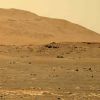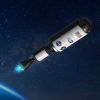-
 +19 +1
+19 +1NASA is looking for people to test out its Mars simulator for a year
The agency is accepting applicants for the second cohort of its Mars simulator mission. Participants will live and work from a 3D-printed, 1,700-square-foot facility at NASA's Houston space center.
-
 +25 +1
+25 +1Flipped Bit Could Mark The End Of Voyager 1‘s Interstellar Mission
Flight controllers have determined that the problem lies within the one remaining FDS on board (the backup FDS failed back in 1981), most likely thanks to a single bit of corrupted memory.
-
 +4 +1
+4 +1James Webb Space Telescope finds possible evidence of dark stars
A trio of astrophysicists, two from Colgate University and the third from the University of Texas, has found evidence of dark stars courtesy of data from the James Webb Space Telescope. In their study, reported in Proceedings of the National Academy of Sciences, Cosmin Ilie, Jillian Paulin and Katherine Freese, analyzed three galaxies spotted by the JWST and how they might relate to dark stars.
-
 +21 +1
+21 +1NASA's quirky new lunar rover will be the first to cruise the moon's south pole
It’s no simple feat to send a rover to space, land it on a celestial body, and get the wheels rolling. NASA has used all kinds of techniques: The Pathfinder rover landed on Mars in 1997 inside a cluster of airbags, then rolled down its landing vehicle’s “petals,” which bloomed open like a flower, to the dusty surface. Cables attached to a rocket-powered “sky crane” spacecraft dropped the Perseverance Mars rover to the Red Planet’s surface in 2021.
-
 +33 +1
+33 +1Seven Amazing Accomplishments the James Webb Telescope Achieved in Its First Year
The James Webb Space Telescope, the largest and most sophisticated space observatory ever built, has been sending back images and data for almost a full year now—and in that time it has delivered a treasure trove of information about everything from stars and planetary systems in our own galactic neighborhood to distant galaxies that formed when the universe was a tiny fraction of its current age.
-
 +20 +1
+20 +1Ingenuity helicopter phones home from Mars after 63-day silence
After 63 days of silence, the Mars Ingenuity helicopter is talking again. The little chopper took to the Martian skies on April 26 for its 52nd flight but lost contact with mission controllers before landing — creating a monthslong communications blackout.
-
 +2 +1
+2 +1NASA Re-Establishes Contact With Mars Ingenuity Helicopter
Washington: The official mission logbook now lists the Ingenuity Mars Helicopter's 52nd flight as a success. The trip took place on April 26 but mission controllers at NASA's Jet Propulsion Laboratory in Southern California lost communication with the chopper as it dropped towards the Mars surface for landing.
-
 +12 +1
+12 +1Just How Super Is The Coming Supermoon?
July's full moon will be thousands of miles closer to us than usual. Learn how to measure it with your hand.
-
 +4 +1
+4 +1Supermassive black hole at heart of ancient galaxy ‘far larger than expected’
A supermassive black hole discovered at the heart of an ancient galaxy is five times larger than expected for the number of stars it contains, astronomers say. Researchers spotted the immense black hole in a galaxy known as GS-9209 that lies 25bn light-years from Earth, making it one of the most distant to have been observed and recorded.
-
 +25 +1
+25 +1First up-close images of Mars’s little-known Moon Deimos
The United Arab Emirates’ space probe Hope has taken the first high-resolution images of the farside of Mars’s moonlet Deimos. The observations add weight to the theory that Deimos formed together with Mars, rather than as an asteroid that was captured in the planet’s orbit, mission scientists say.
-
 +15 +1
+15 +1NASA's Curiosity Mars rover gets a major software upgrade
The update brings loads of improvements, the most significant being new driving capabilities.
-
 +17 +1
+17 +1Astronauts that hibernate on long spaceflights is not just for sci-fi. We could test it in 10 years.
"Before we can use it on people, everything needs to be adjusted. However, I believe that a feasible timetable is 10 years." Within ten years, a scholar with the European Space Agency (ESA) believes that it will be possible to conduct the first hibernation experiments on humans.
-
 +22 +1
+22 +1It's a bird! It's a plane! It's a pretty neat planetary viewing!
This week, you have an opportunity to acquaint yourself with some of our solar system neighbors and reduce some of your screen time.
-
 +29 +1
+29 +1Strange circular dunes on Mars spotted in these NASA photos
Planetary scientists have captured an image of near-perfectly circular sand dunes on the surface of Mars. While sand dunes across the Red Planet come in a wealth of shapes and sizes, such well-defined circles are unusual.
-
 +4 +1
+4 +1Bill Gates would rather pay for vaccines than travel to Mars
The Microsoft co-founder also believes artificial intelligence will "dramatically" transform humanity.
-
 +11 +1
+11 +1NASA tested new propulsion tech that could unlock new deep space travel possibilities
With the successful launch of Artemis I behind it, NASA has been doubling down on efforts to make deep space travel – and it’s reported future trips to the Moon and Mars – easier to achieve. We’ve already reported on why the Space Launch System used for the Artemis mission isn’t sustainable, but now NASA has tested a new propulsion tech that could cut down on the fuel needed for those missions.
-
 +14 +1
+14 +1NASA will join a military program to develop nuclear thermal propulsion
Nearly three years ago, the US Defense Advanced Research Projects Agency announced its intent to develop a flyable nuclear thermal propulsion system. The goal was to develop more responsive control of spacecraft in Earth orbit, lunar orbit, and everywhere in between, giving the military greater operational freedom in these domains.
-
 +17 +1
+17 +1We will never be able to live on another planet. Here’s why
This futuristic dream-like scenario is being sold to us as a real scientific possibility, with billionaires planning to move humanity to Mars in the near future. For decades, children have grown up with the daring movie adventures of intergalactic explorers and the untold habitable worlds they find. Many of the highest-grossing films are set on fictional planets, with paid advisors keeping the science ‘realistic’. At the same time, narratives of humans trying to survive on a post-apocalyptic Earth have also become mainstream.
-
 +19 +1
+19 +1NASA Releases New Images of Winter Frost on Mars
The surface of Mars gets somewhat warm during the summer, but on average, temperatures on the surface are around -81 degrees F. It’s too cold for human life, and in case you didn’t know, Mars has snow, frost, and even dry ice. NASA recently released a slew of images showing the “winter wonderland on Mars,” and the photos are wild. It’s not often that we get a look at winter on Mars, mainly because the red planet’s elliptical orbit takes a lot longer than Earth.
-
 +17 +1
+17 +1Lockheed Martin's vision for Mars base in 2050
At its "Destination: Space 2050" event in October Lockheed Martin (one of the largest American aerospace, advanced technologies and defense companies) shared its vision of a vibrant space economy in the year 2050. Here Lockheed Martin envisions a future on Mars with "power beaming, laser communications and robotic in-situ construction for a sustainable living and economic environment". Note company's conceptual Mars lander on the landing pad.
Submit a link
Start a discussion




















